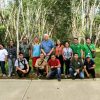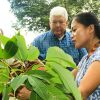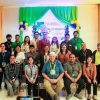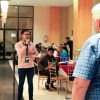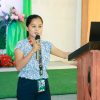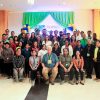𝗝𝘂𝗻𝗲 𝟯𝟬, 𝟮𝟬𝟮𝟯 || 𝑰𝒑𝒊𝒍, 𝒁𝒂𝒎𝒃𝒐𝒂𝒏𝒈𝒂 𝑺𝒊𝒃𝒖𝒈𝒂𝒚 – The Philippine Rubber Research Institute (PRRI) successfully conducted a Capacity Development Seminar titled “Safeguarding The Philippine Rubber Industry: Exploring Effective Strategies for Assessing Emerging Diseases” at Jackies’ Hotel and Restaurant today. The event united prominent stakeholders, including the Provincial Agriculturist, National Government Agencies (NGAs), Local Government Units (LGUs), industry experts, professionals, and Rubber Farmer Groups. Their collective purpose was to deliberate essential strategies intended to safeguard the Philippine rubber industry against the threat of emerging diseases. The seminar’s highlight was the esteemed presence of Dr. Robert Kemerait, Jr., a renowned Professor and Extension Specialist from the Department of Plant Pathology at the University of Georgia in Tifton, Georgia, USA.
The seminar commenced with a warm welcome from Mr. Glenn Carl Andahalao, representing Director Cheryl Lazaga Eusala. Mr. Andahalao expressed gratitude to all participants for their attendance and emphasized the importance of addressing emerging diseases for the sustainable growth of the Philippine rubber industry.
Dr. Jill Villanueva, in her presentation, shed light on the significance of rubber and the critical need to protect it. She also discussed the prevalence and occurrence of Pestaloptiopsis Leaf Fall Disease (PLFD) in the Philippines, highlighting the partnerships and collaborations with various institutions and agencies in combating the disease.
Dr. Kemerait’s presentation emerged as the pinnacle of the seminar, as he graciously traversed across continents from the United States to grace the event with his invaluable insights. With resolute generosity, he underscored the significance of comprehending the foundation, which is the fundamental underpinnings of the disease. Drawing upon his extensive research on Corenyspora cassiicola in cotton, Dr. Kemerait drew parallels to Pestalotiopsis, emphasizing the imperative to delve deeper into the origins of the disease. His profound commentary highlighted that the quest for establishing optimal management practices for PLFD remains an ongoing endeavor.
During the Open Forum session, Mr. Meynard Abello presided over discussions where participants raised important questions. Some topics included the roles of different entities in combating the disease, the usage of fungicides, and the occurrence of similar symptoms in coffee and durian. Additionally, questions were asked about the necessity of Good Agricultural Practices (GAP) and whether Corynespora cassiicola attacks rubber. Dr. Kemerait and Dr. Jill Villanueva expertly addressed these inquiries, providing valuable insights and clarifications.
Following the seminar, participants had the opportunity to witness PLFD firsthand during a field visit to Brgy. Guituan, Ipil, Zamboanga Sibugay. This practical experience provided attendees with valuable insights into the symptoms and impact of the disease on rubber plantations. Observing the affected areas firsthand further reinforced the importance of the seminar’s discussions and strategies in combating emerging diseases in the Philippine rubber industry.
The Capacity Development Seminar, along with the field visit, proved to be an immersive and informative experience for all participants. By combining theoretical knowledge with practical observations, industry professionals are better prepared to tackle the challenges posed by emerging diseases in the Philippine rubber industry.
– 𝕁𝕦𝕝𝕚𝕦𝕤 𝔾. 𝔹𝕚𝕠𝕝𝕒𝕟𝕘𝕠
